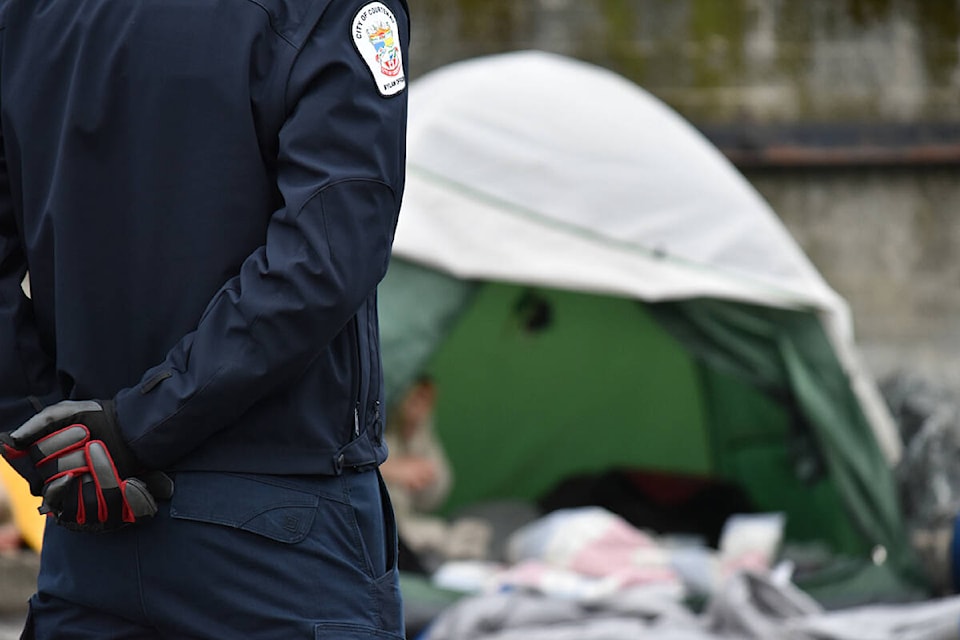During the past few months, communities throughout B.C. have witnessed periodical and seemingly random street sweeps - also known as homeless encampment clean-ups - conducted mainly by bylaw enforcement and police officers.
RELATED:
RELATED:
RELATED:
I do not believe that dispossessing our unhoused population of their belongings is a productive way to address the homelessness issue. These draconian measures are intrinsically counterproductive and only perpetuate an endless cycle of misery while further endangering an already at-risk population.
The bylaw
The legal backbone guiding the enforcement of these cleanups is typically detailed under a local municipal bylaw. In Courtenay, it’s covered in three brief sections of a single bylaw passed in 1996: .
In short, those three sections define that anything in a public space that will “cause an obstruction,” or “which causes or is likely to cause a nuisance” is liable for being “removed, detained and impounded by” authorized local enforcers.
The “nuisance(s)… may be recovered by the owner” for a fee that increases daily at the city’s public works yard within 30 days, making it gradually more difficult for people struggling with their finances to recover belongings that were swept.
If unclaimed after 30 days, the city can auction items over $300. Otherwise, “any garbage (or) rubbish… with an apparent value of less than $300… may be removed to a garbage dump and disposed of therein.”
Loose definitions and subjective interpretations
This nearly three-decade-old legal document is antiquated and not adapted to today’s reality.
Proposed in a time when homelessness was virtually non-existent in the region, this bylaw is now in dire need of being amended.
As of 2023, the Comox Valley now counts - a number that doubled since 2020.
RELATED:
Using words like nuisance, garbage, and rubbish, is inherently ambiguous, providing room for interpretation and allowing local authorities to apply the bylaw arbitrarily.
What if the one bylaw officer’s call results in the death of an unhoused person?
What if, during one of our many rainy winter weeks, local authorities sweep a homeless encampment, leaving someone without tents, sleeping bags, and other personal belongings?
This could be a death sentence.
After all, one person’s ‘trash’ is another man’s survival essentials.
Where would these homeless people go following a cleanup without any means of protecting themselves from the elements? An emergency homeless shelter? As of Dec. 15, our region still doesn’t have one.
ARTICLE:
ARTICLE:
Damaging and harmful repercussions
Exacerbating the situation, individuals who have lost their survival essentials might resort to theft, trespassing, and other minor offences, perpetuating an endless vicious cycle.
Some critics of homelessness may exploit this cycle to advocate for increased enforcement measures. How is that logic supposed to work?
By implementing those street sweeps, this bylaw endangers the lives of our unhoused population, hence infringing on their constitutional and human rights law as outlined in section 7 of the Canadian Charter of Rights and Freedoms.
I’m no jurist, but to have a local bylaw superseding our Charter astounds me.
For many of us living in the comfort of our homes, a tent, a pocket stove, a pair of thick wool socks, and a backpack may only symbolize enjoyable family time on a yearly camping trip.
For those without homes, these possessions hold profound significance. A street sweep can turn out to be a deeply traumatic experience, severing one’s last connection to human dignity.
I think we should all, now and then, work our empathy muscles and think of those out there living in the cold and rain, all the while struggling with mental health and/or substance use issues when leaving and returning to the warmth and security of our house.
Let me make it clear that I do not condone the anarchic and disruptive pitching of tents everywhere around the city’s public space.
I also recognize that our bylaws and police officers may sometimes have to deal with unco-operative, problematic, or, in some cases, violent individuals. Working with an unhoused population, many of whom may be dealing with mental health issues and/or substance use disorder, is most definitely not an easy task.
My intentions here are not to discredit the enforcers and the city’s work, assign blame, or pinpoint a culprit for this crisis. I simply want to reiterate my belief that the street sweeps are fundamentally counterproductive.
Perhaps redirecting the taxpayer money allocated for street sweeps towards comprehensive training for bylaw officers and police officers in effectively handling this peculiar population could be a more constructive approach.
Maybe we can amend the current bylaw and make it more suitable to today’s reality.
Maybe we could find a way to speak and communicate with our local unhoused population to prevent what may be considered disorderly behaviours.
Maybe we could push for the opening of a permanent open space and low-maintenance shelter for our unhoused population to congregate and ensure their security.
If we don’t bring any changes to this issue now, the cost of our inaction today will weigh heavily on tomorrow.
Olivier Laurin is a reporter at the Comox Valley Record


